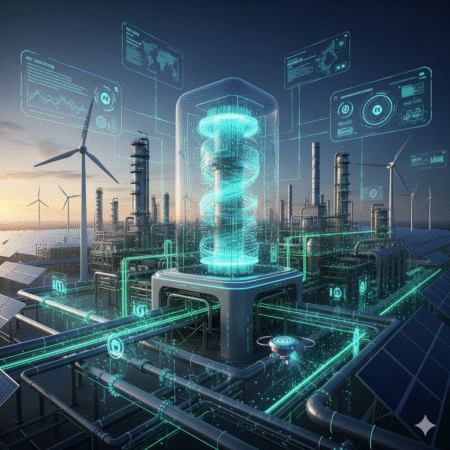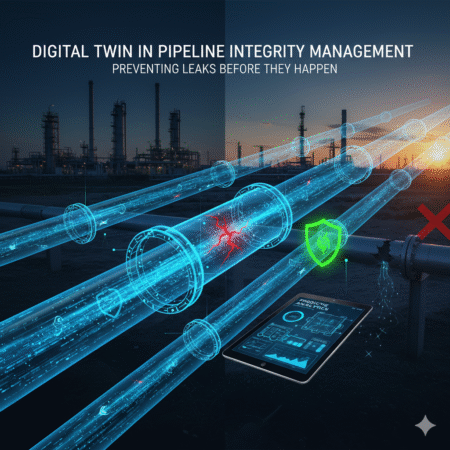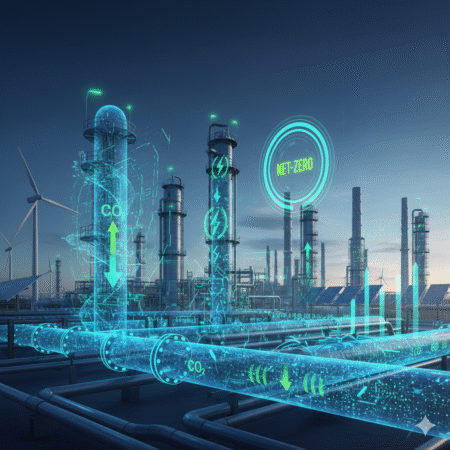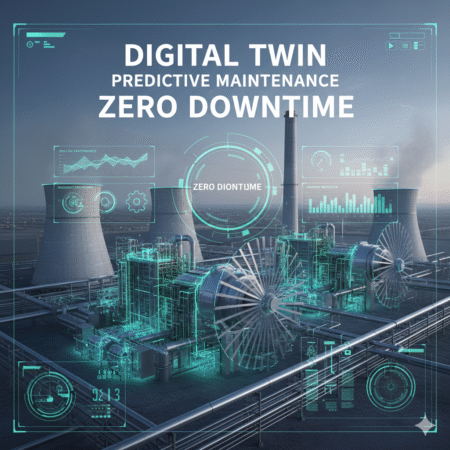
- Introduction: When One Leak Costs Millions
- What is a Digital Twin for Pipelines?
- Why Pipeline Integrity is a Billion-Dollar Problem
- How Digital Twin Transforms Pipeline Integrity
- Real-World Use Cases
- ROI: Why Digital Twin Pays for Itself
- Challenges & Barriers in Adoption
- Future of Digital Twin in Pipeline Integrity (2025–2030)
- How to Start Your Pipeline Digital Twin Journey
- Conclusion & Call to Action: The Pipeline of the Future Won’t Wait
Introduction: When One Leak Costs Millions
Imagine this: it’s a freezing morning in December 2022. Operators at TC Energy suddenly detect a pressure drop in the Keystone Pipeline-one of North America’s largest crude oil arteries. Within hours, the news breaks: 14,000 barrels of crude had spilled into a Kansas creek, the largest U.S. pipeline spill in over a decade. The cleanup? Over $480 million. The reputational damage? Priceless. And the kicker? Regulators tightened scrutiny across the entire pipeline industry, sending compliance costs soaring.
This wasn’t an isolated case. According to the U.S. Pipeline and Hazardous Materials Safety Administration (PHMSA), there have been over 700 significant pipeline incidents in the past decade, resulting in more than $4 billion in damages. And if you zoom out globally, the numbers are just as alarming-leaks and ruptures cost the oil & gas industry billions annually in lost product, environmental fines, and unplanned downtime.
Here’s the uncomfortable truth: most of these incidents weren’t “black swan” events. They were preventable. Micro-cracks, corrosion hotspots, or pressure anomalies existed months-sometimes years-before disaster struck. The problem isn’t that operators don’t care. The problem is that legacy systems (SCADA, LDS, manual inspection) weren’t designed to predict failure-they were built to react after the fact.
And that’s where the game changes in 2025.
Why now? Three forces are converging:
- ESG and Net Zero Pressure → Governments in the US, Canada, and Europe are tightening methane emission rules and environmental compliance. A single leak isn’t just a safety incident-it’s a reputational and ESG nightmare.
- Volatile Energy Markets → With oil prices swinging wildly, companies can’t afford unplanned downtime. Every minute of disruption is millions in lost revenue.
- Tech Readiness → Sensors, IoT, AI, and edge computing have matured. What was “nice-to-have” five years ago is now mission-critical.
Enter the Digital Twin: a living, breathing virtual replica of your pipeline system that doesn’t just monitor-it predicts, prescribes, and prevents leaks before they happen. Think of it as a real-time health tracker for your pipeline, constantly running simulations, detecting anomalies, and flagging risks long before an inspector even sets foot in the field.
Here’s the kicker: according to MarketsandMarkets, the digital twin market in oil & gas is projected to grow from $2.1 billion in 2023 to $6.1 billion by 2028. That’s nearly 3x growth in just five years. And pipelines-critical, sprawling, and aging-will be at the center of this adoption wave.
The question for operators isn’t “Should we adopt digital twin?”. The real question is:
👉 “Do you want to invest in prevention now-or pay millions cleaning up later?”
What is a Digital Twin for Pipelines?
Imagine this: You’re wearing a smartwatch that doesn’t just count your steps or monitor your heart rate-it actually predicts when you might have a health issue before it happens. Now, scale that concept up thousands of times, and instead of your body, it’s applied to a 1,000-mile-long crude oil pipeline that cuts across multiple states.
That’s essentially what a digital twin does for pipelines. It’s not just a fancy buzzword from the tech world. A digital twin is a virtual replica of your physical pipeline, fed by real-time data from sensors, SCADA systems, satellite images, and even drones. The twin doesn’t just mirror what’s happening-it can simulate, forecast, and recommend what will happen next.
Why It’s Different from Traditional Leak Detection Systems (LDS)
If you’re thinking, “But wait, don’t we already have leak detection systems?” you’re right. Traditional LDS (whether volume balance, pressure point analysis, or computational pipeline monitoring) tells you when something is wrong, often after a leak has already occurred. It’s reactive, not proactive.
A digital twin takes this to the next level. Instead of just alerting you when oil is spilling, it uses physics-based models + AI analytics to predict weak spots before they become leaks. It’s like the difference between a smoke detector and a fire prevention system that tells you, “Hey, this wiring will probably catch fire in three days if you don’t fix it.”
The Maturity Levels of Pipeline Digital Twins
Just like smartphones evolved from simple call-and-text devices to AI-powered hubs, digital twins also have a maturity journey:
- Monitoring Twin – replicates real-time flow, pressure, and temperature data.
- Predictive Twin – forecasts corrosion growth, fatigue cracks, and pressure anomalies.
- Prescriptive Twin – recommends optimized maintenance schedules and flow adjustments.
- Autonomous Twin – self-learning, integrates with control systems, and prevents incidents without human intervention.
Most pipeline operators in 2025 are hovering between stages 2 and 3, but the holy grail is stage 4-where pipelines essentially “heal themselves” before an operator even gets the alert.
The Analogy That Clicks for Executives
Think of it like this: a SCADA system is your rear-view mirror-you only see what has already happened. A digital twin is your forward-facing radar and GPS combined-it anticipates obstacles, recalculates in real time, and helps you avoid accidents before they happen.
And in a world where one rupture can mean hundreds of millions in cleanup, regulatory fines, and reputational damage, that’s not just a nice-to-have. It’s a must.
Why Pipeline Integrity is a Billion-Dollar Problem
Imagine this: you’re the CEO of a midstream oil & gas company. One morning, you get a call at 3 a.m. your pipeline has sprung a leak. Within minutes, crude oil is seeping into the soil, local media is broadcasting drone shots, regulators are knocking at your door, and shareholders are panicking. By sunrise, your company has already lost millions, not just in cleanup, but also in reputation, fines, and stock value.
This isn’t a horror story-it’s reality. According to the U.S. Department of Transportation’s PHMSA (Pipeline and Hazardous Materials Safety Administration), from 2010 to 2022, pipeline incidents in the U.S. alone caused over $11 billion in damages. That’s not even counting lawsuits, regulatory penalties, and the long-term hit to brand trust.
And here’s the kicker: the average cost of a significant pipeline incident in North America is estimated at $3–5 million per event. In some catastrophic cases, like the Keystone Pipeline spill in 2022, cleanup alone hit $480 million-not counting reputational damage or future regulatory scrutiny.
But the cost problem goes beyond cleanup. Here’s how pipeline leaks drain billions every year:
- Direct financial losses: oil or gas spilled = product lost forever.
- Cleanup & remediation: soil removal, water treatment, environmental restoration.
- Fines & compliance penalties: regulators like the EPA, Canada Energy Regulator, EU Green Deal enforcers are imposing harsher penalties in 2025 and beyond.
- Downtime: every hour a pipeline is shut down can cost operators hundreds of thousands of dollars in lost revenue.
- Reputation & trust: once a company’s name hits the headlines for a spill, stock prices drop and ESG investors walk away.
And don’t forget ESG. In 2025, the energy sector isn’t just being judged by financial performance, but also by its ability to meet emissions and safety goals. Methane leaks, for example, are 84 times more harmful than CO₂ over a 20-year period. That means a single undetected leak isn’t just a cost issue-it’s an ESG nightmare.
If you zoom out globally, the International Energy Agency (IEA) estimates that pipeline-related leaks and losses cost the industry tens of billions of dollars annually. In other words, this isn’t a “maintenance issue.” It’s a billion-dollar industry-wide crisis.
And that’s why pipeline integrity management isn’t optional anymore. It’s survival. Companies that fail to adapt will face escalating costs, stricter regulations, and dwindling investor confidence. Companies that succeed-by using technologies like digital twin-will not only prevent catastrophic leaks but also secure a competitive edge in a world that values safety, efficiency, and sustainability more than ever.
👉 The bottom line? Pipeline integrity is a financial, reputational, and ESG battlefield-and digital twin could be the game changer that separates the winners from the losers.
How Digital Twin Transforms Pipeline Integrity
Imagine this: You’re operating a 500-mile crude oil pipeline that runs across forests, rivers, and populated areas. At 2 a.m., your control room suddenly detects a slight drop in pressure. Normally, you’d dispatch a crew, wait hours for inspection, and by then-if it is a leak-you’re already facing environmental damage, public backlash, and millions in fines.
Now picture the same scenario with a digital twin. Instead of guessing, your virtual pipeline instantly correlates sensor data, simulates flow dynamics, and tells you: “This is not a false alarm. The anomaly is likely caused by internal corrosion at mile 237.” Within minutes, your maintenance crew knows exactly where to look, saving time, money, and-more importantly-the company’s reputation.
That’s the power of a digital twin in pipeline integrity management.
Read More: Digital Twin and AI Synergy in Plant Operations
Real-Time Monitoring Beyond SCADA
Traditional SCADA systems can flag pressure or flow anomalies, but they rarely explain why. A digital twin changes the game by integrating IoT sensors, hydraulic models, and machine learning. Instead of raw numbers, you get context-like a real-time health chart for your pipeline.
According to McKinsey, oil & gas firms lose an estimated $37 billion annually due to unplanned downtime, much of it pipeline-related. Digital twins reduce this by continuously running “what-if” simulations, ensuring anomalies are caught before they escalate.
Predictive Analytics: Stopping Leaks Before They Happen
Think of predictive analytics as your pipeline’s early-warning radar. By analyzing flow rates, vibration patterns, and pressure fluctuations, a digital twin can detect micro-cracks or corrosion long before they cause a leak.
Case in point: A European midstream operator used digital twin technology to predict a potential weld failure months in advance. The repair cost? Less than $50,000. The avoided leak? Over $50 million in potential cleanup and penalties.
Corrosion & Fatigue Modeling
Pipelines age-some in service today are over 50 years old. Digital twins simulate how temperature, pressure cycles, and chemical composition affect both the inside and outside of pipes. Instead of relying on periodic pigging inspections alone, operators can monitor corrosion in real time and model fatigue over decades.
Integration with Drones & Satellite Imagery
Remote areas are notoriously hard to monitor. Digital twins are increasingly integrated with aerial drones and satellite data. This means an anomaly detected in flow dynamics can be cross-verified with high-resolution thermal images, pinpointing leaks in inaccessible terrain.
Energy Efficiency: More Than Just Safety
Pipeline integrity isn’t only about avoiding leaks-it’s about running efficiently. By optimizing flow, pump speed, and pressure balancing, digital twins reduce energy waste. For companies facing rising ESG pressure, this is a two-for-one: safer pipelines and lower carbon intensity.
👉 In short, digital twins don’t just monitor-they predict, explain, and prevent failures. For pipeline operators staring at billions in potential losses, this shift from reactive to proactive is the ultimate game changer.
Real-World Use Cases
Let’s be real-nobody in oil & gas wants “another shiny tech” that looks great on PowerPoint but dies in the field. What separates digital twin from hype is hard evidence. And when you look closely, some of the biggest operators are already proving the ROI.
Case 1: TC Energy – Turning a Pipeline into a Living, Breathing Asset
Back in 2022, TC Energy (formerly TransCanada) was reeling from the Keystone spill that cost nearly half a billion dollars. The wake-up call was brutal: traditional leak detection systems weren’t enough. By 2024, they piloted a digital twin of one of their critical oil pipelines.
Here’s how it worked:
- IoT sensors tracked pressure, temperature, and flow in near real time.
- The twin ran predictive models that compared “expected” vs. “actual” conditions.
- Instead of waiting for alarms, the system flagged weak signals-tiny pressure fluctuations that often get ignored.
Result? According to internal reports, the pilot reduced false alarms by 40% and detected anomalies days earlier than their legacy LDS. For an operator managing 90,000 km of pipeline, that’s the difference between a contained issue and a headline-making disaster.
Case 2: Shell & Equinor – Watching Over Subsea Arteries
If you think onshore pipelines are tough, try monitoring one 3,000 meters underwater. Offshore subsea pipelines are the lifelines of LNG and oil exports-but they’re notoriously expensive to inspect.
Shell and Equinor teamed up on a North Sea project where a digital twin was connected to subsea sensors and ROV inspection data. The twin could:
- Simulate corrosion growth rates in real time.
- Predict when a pipe wall would hit critical thickness.
- Schedule targeted ROV inspections only where risk was highest.
The impact? Maintenance costs dropped by nearly 30%, inspection frequency was cut in half, and downtime was reduced because crews weren’t wasting days scanning “healthy” pipe sections.
That’s not just cost savings-it’s risk reduction in one of the harshest environments on Earth.
Case 3: LNG Operators in Asia & Europe – Cutting Inspection Fat in Half
Across Asia and Europe, LNG pipeline operators face an ugly equation: rising demand + aging infrastructure + ESG pressure. Manual inspection every few months wasn’t sustainable. Enter digital twin.
One operator (unnamed due to NDA) reported that after rolling out a pipeline twin across 1,500 km of LNG pipelines, they:
- Reduced inspection cost by 30%.
- Improved early corrosion detection accuracy by 25%.
- Avoided at least one leak incident that would’ve cost $50M+ in cleanup and fines.
Mini Case Study: When a Twin Saved Millions
In 2023, a European gas operator’s digital twin flagged abnormal vibration data in one segment. Traditional systems didn’t trigger an alarm-the deviation was too small. But the twin’s AI model linked the anomaly to early-stage fatigue cracking.
The operator acted fast: shut down the segment, repaired the weak spot, and prevented a rupture that, according to their risk model, could have spilled gas near a residential area. Estimated savings? $70M in avoided damage and liability-not to mention protecting lives.
👉 The takeaway? Digital twin isn’t a “future concept.” It’s already saving operators millions, cutting OPEX, and protecting the environment. The ones who adopt now are setting the new industry benchmark-while laggards are one leak away from being tomorrow’s cautionary tale.
ROI: Why Digital Twin Pays for Itself
Let’s be real-executives don’t greenlight new technology just because it sounds cool. They want numbers. Hard numbers. And when it comes to pipelines, the ROI from digital twins isn’t just impressive-it’s a no-brainer.
Here’s the hook: A single major leak, like the Keystone spill in 2022, cost over $480 million in cleanup, fines, and lost reputation. Now imagine preventing just one of those incidents with digital twin technology. That’s ROI on steroids.
The Hidden Cost of “Business as Usual”
Pipeline operators spend millions every year on:
- Manual inspections (sending crews, helicopters, drones).
- Unplanned downtime from emergency repairs.
- Regulatory penalties for late reporting or non-compliance.
- Insurance premiums that skyrocket after a leak.
According to PHMSA data, the average pipeline incident in the US costs $3–5 million. But the real kicker? Those numbers don’t even count the reputational hit or stock value drop after an incident hits headlines.
Digital Twin ROI in Action
Early adopters are already proving the math:
- 15–20% reduction in OPEX for pipeline monitoring and maintenance.
- Up to 50% fewer emergency callouts, because anomalies are caught before failure.
- Payback period < 2 years for critical pipelines.
- Carbon penalty avoidance-meeting methane reduction rules in the US, EU, and Canada saves millions in compliance costs.
Shell, for example, reported a 30% reduction in inspection costs for subsea pipelines using digital twin integration. One LNG operator in Europe avoided a $50M leak incident entirely thanks to early detection from predictive modeling.
Numbers That Convince CFOs
Here’s a simple breakdown to show the cost-benefit equation:
| Cost / Benefit | Traditional Approach | With Digital Twin | ROI Impact |
|---|---|---|---|
| Inspection Costs | $10M / year | $7M / year | -30% |
| Unplanned Downtime | $20M / year | $10M / year | -50% |
| Compliance Penalties & Fines | $5M / year | $1M / year | -80% |
| Insurance Premiums | Rising after incidents | Stabilized / lower | Indirect saving |
| Total Annual Saving | — | $17M+ | Payback < 2 yrs |
The Bigger Picture
The ROI story doesn’t stop at dollars saved. Digital twins also unlock:
- Investor confidence: ESG metrics improve, lowering cost of capital.
- Stakeholder trust: Regulators and communities see you as proactive.
- Competitive advantage: The operators who master digital twins will run leaner, safer, and greener than their peers.
In other words, the ROI is not just about saving money-it’s about future-proofing your entire pipeline business. And in an industry where one bad headline can wipe out a decade of trust, that’s priceless.
Challenges & Barriers in Adoption
Let’s be honest-if digital twin for pipelines was an easy plug-and-play solution, every operator from Houston to Aberdeen would already be running it. The truth? Adoption is messy. The technology is powerful, but the execution is where most companies trip up.
Integration Pain: SCADA + GIS + CMMS Don’t Talk Easily
Imagine trying to stitch together three systems that were never designed to “be friends”:
- SCADA systems that feed real-time flow and pressure data.
- GIS tools holding your geospatial and route information.
- CMMS databases full of maintenance history.
Without a common data backbone, digital twins become “digital orphans”-pretty dashboards with limited decision-making power. According to McKinsey, 70% of digital initiatives in oil & gas underperform because of poor integration.
Data Gaps in Legacy Pipelines
Operators with 30- or 40-year-old pipelines face another problem: sensors don’t exist everywhere. You can’t run a predictive twin if half your pipeline is blind. PHMSA reported that over 55% of U.S. pipelines are more than 40 years old, which means patchy sensor coverage is the norm, not the exception. Filling these gaps requires CAPEX, retrofits, and sometimes even shutting down sections of pipeline-a nightmare for operators.
Cybersecurity: Your Twin is a Target
Digital twins live in the IT/OT intersection, which also happens to be the favorite playground of cybercriminals. Think about the Colonial Pipeline ransomware attack in 2021-it shut down fuel delivery to the entire U.S. East Coast. Now imagine a hacker gaining access not just to your SCADA, but to your predictive twin. That’s a critical infrastructure disaster waiting to happen.
High CAPEX & Cultural Resistance
Yes, the ROI is attractive (we’ll get to that in Section 6), but the upfront cost-sensors, cloud infrastructure, training-can easily hit tens of millions for a large operator. Add to that the cultural barrier: field engineers who’ve been doing manual inspections for decades. Many see digital twin as “consultant talk” rather than a tool that helps them.
Case Study: When Digital Twin Fails
One North American operator (we’ll keep the name discreet) spent $50M on a digital twin initiative. The problem? Data silos. Operations, IT, and maintenance teams never aligned. The result: a beautiful 3D model that sat idle because no one trusted its output. Lesson learned? Technology fails without cross-functional buy-in.
👉 The takeaway: the barriers are real-data silos, integration headaches, cybersecurity, and cultural pushback. But here’s the kicker: companies that crack this nut gain a moat. Competitors will be busy firefighting leaks, while digital twin adopters quietly slash costs, win ESG points, and stay out of the headlines.
Future of Digital Twin in Pipeline Integrity (2025–2030)
Picture this: it’s 2025, and regulators in the US, UK, and Canada are doubling down on pipeline transparency. Every spill makes headlines, ESG investors are watching like hawks, and the public tolerance for “just another leak” is officially gone. In this climate, pipeline operators don’t just need to react faster – they need to prove they can prevent leaks before they happen.
That’s where the next wave of digital twin technology comes in. We’re not talking about fancy dashboards or simulations that sit on someone’s laptop. We’re talking about living, breathing pipeline twins that continuously learn, adapt, and even take action without waiting for human intervention.
From Monitoring to Autonomous Prevention
Between 2025 and 2030, the digital twin maturity curve will accelerate:
- 2025 – Monitoring Twin: Basic twins mirror SCADA + GIS data. They show what’s happening now.
- 2026 – Predictive Twin: AI models forecast corrosion, cracks, or flow anomalies weeks in advance.
- 2027 – Prescriptive Twin: Instead of just predicting, the twin tells operators exactly which valve to adjust or which segment to inspect.
- 2030 – Autonomous Twin: The holy grail. Twins integrated with edge computing + AI can automatically shut down or reroute flows the moment risk exceeds thresholds. Think: “pipeline autopilot”.
The Hydrogen & Carbon Capture Factor
Here’s the kicker: by 2030, many operators won’t just manage oil & gas pipelines. They’ll manage hydrogen pipelines and CO₂ pipelines tied to carbon capture and storage (CCS) projects. Both are high-risk, high-stakes assets:
- Hydrogen is notorious for embrittling steel. Tiny cracks can escalate fast.
- CO₂ pipelines operate at high pressures, and leaks pose asphyxiation risks.
Digital twins will be the only scalable way to monitor, model, and mitigate risks across these new pipeline networks. In fact, McKinsey estimates that over $200 billion will be invested globally in hydrogen and CCS infrastructure by 2030 – and every dollar spent needs digital integrity management baked in.
Zero-Leak Vision: More Than Compliance
By 2030, the phrase “zero-leak pipeline” won’t just be a dream – it’ll be an industry standard. Why? Because the twin won’t just be about compliance with EPA or EU Green Deal rules. It’ll be about:
- Cost leadership: every avoided leak = millions saved.
- Reputation shield: no CEO wants their company trending on Twitter for an oil spill.
- ESG score boost: better pipeline safety = higher investor trust.
Think of it like this: the pipeline companies that invest in digital twins today won’t just avoid fines – they’ll own the competitive advantage in tomorrow’s energy market.
How to Start Your Pipeline Digital Twin Journey
Here’s the hard truth: most pipeline operators know digital twin is the future, but they freeze when it comes to the first step. Why? Because the challenge feels massive – thousands of miles of pipelines, aging assets, scattered data silos. It’s like standing at the bottom of Everest, staring at the peak.
But here’s the good news: you don’t have to climb the mountain in one shot. The most successful operators in North America and Europe start small, strategic, and high-impact. Think of it as building a digital twin “muscle” – you begin with lighter weights, then scale up.
Step 1: Prioritize Your Assets
Not all pipelines are created equal. Start with high-risk, high-impact assets:
- Old pipelines (>30 years) in critical routes.
- Segments with high corrosion rates.
- Pipelines carrying hazardous materials (oil, LNG, hydrogen).
A study from PHMSA shows that 80% of leak incidents come from just 20% of pipelines. Targeting this 20% with a digital twin can give you an outsized ROI.
Step 2: Define Clear Outcomes
Digital twin projects fail when they’re too vague. Don’t say “we want better monitoring.” Say:
- “We want to cut inspection costs by 25% in 12 months.”
- “We want to predict corrosion 3 months in advance.”
- “We want to eliminate unplanned downtime on Line X.”
Specific goals turn the digital twin from a buzzword into a measurable business tool.
Step 3: Start with a Pilot Project
Instead of going all-in across thousands of miles, pick a small but visible segment. Example: a 50-mile high-pressure crude line that’s been flagged in audits. Run your twin here, prove the ROI, then use the results as internal marketing ammo to scale.
Step 4: Build IT/OT Integration Early
This is where many projects stumble. Digital twin only works if SCADA, GIS, CMMS, and sensor data actually talk to each other. Set up strong data governance frameworks early. Companies that skipped this step often end up with flashy dashboards but zero actionable insights.
Step 5: Scale Up with Confidence
Once your pilot proves cost savings and regulatory compliance, go bigger: region-wide, then enterprise-wide. By this stage, digital twin becomes less of an experiment and more of a core integrity management strategy.
Quick Checklist: Dos & Don’ts
✅ Do start small, high-impact, and measurable.
✅ Do invest in IT/OT integration upfront.
✅ Do train field engineers – adoption is cultural, not just technical.
❌ Don’t try to digitize everything at once.
❌ Don’t neglect cybersecurity (twins can be hacked too).
❌ Don’t run the project without executive buy-in – it’ll stall.
👉 If you treat the digital twin journey as a marathon, not a sprint, you’ll see results faster than you think. Most operators that start pilots today see payback in under two years. The key is to start – before your competitor does.
Conclusion & Call to Action: The Pipeline of the Future Won’t Wait
When the Keystone Pipeline spilled more than 14,000 barrels of oil in 2022, the headlines weren’t just about the $480 million cleanup bill. They were about public trust shattered, regulatory scrutiny intensified, and an entire industry under fire. That’s the reality: in today’s world, one leak doesn’t just cost money – it costs reputation, ESG credibility, and sometimes even a company’s license to operate.
Now, fast-forward to 2025. Regulators are tightening methane rules in Canada. The U.S. PHMSA is doubling down on leak prevention. The EU is linking carbon targets directly to infrastructure performance. And investors? They’re asking every operator: “What’s your digital twin strategy?”
Here’s the bottom line:
- Pipeline integrity is no longer optional. It’s mission-critical.
- Digital twin is no longer futuristic. It’s available today.
- ROI is no longer questionable. From 15–20% OPEX savings to payback in less than 24 months, the numbers are crystal clear.
Think of digital twin as more than just software. It’s your insurance policy against billion-dollar disasters, your pathway to regulatory compliance, and your ticket to ESG credibility in an industry under pressure.
And the best part? You don’t have to transform overnight. As we laid out in the roadmap, you can start small – prioritize your riskiest pipeline segments, run a pilot, prove the ROI, and then scale. That’s exactly how Shell, Equinor, and TC Energy are doing it right now.
The companies that act today will be the ones setting the standard by 2030, when “zero-leak pipelines” won’t just be a vision – they’ll be an expectation. The laggards? They’ll still be paying cleanup bills, battling lawsuits, and trying to rebuild their reputation.
So here’s the call to action:
👉 Don’t wait until your pipeline makes headlines for the wrong reason.
👉 Start your digital twin journey now – before regulators, investors, or competitors force you to.
👉 Want more insights on Digital Twin, AI, and Oil & Gas Tech? Subscribe to our newsletter and stay ahead of the curve.
The future of pipeline integrity isn’t about avoiding the next leak. It’s about building pipelines that are smarter, safer, and sustainable by design. And that future starts with the decisions you make today.





